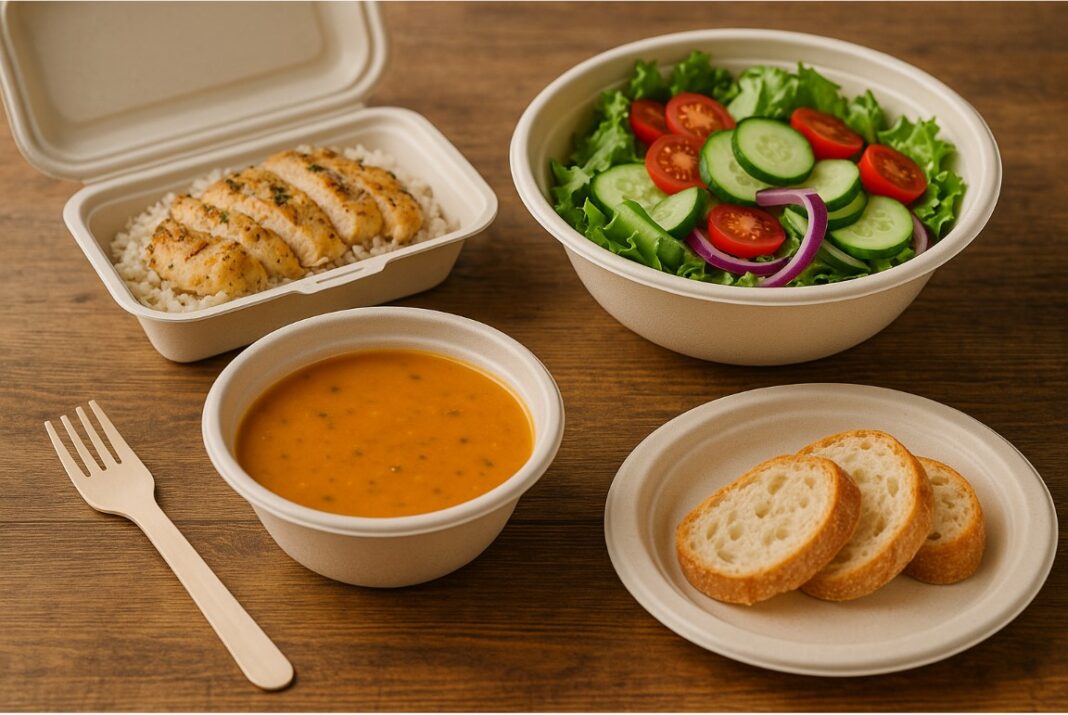Do you think this soup bowl is big enough?” Mia asked as she Instagrammed her brunch.
“It looks perfect,” her friend replied, “but I hope it’s not plastic. Imagine all those cute foodie pics—ruined by guilt!”
This playful exchange isn’t just small talk. Today’s food culture is about aesthetic meets ethics. Foodies want meals that photograph beautifully and respect the planet. That’s why compostable bowls, bagasse containers, and eco salad plates are suddenly trending on menus—and in social feeds.
Global Policy Shifts: The UAE Plastic Ban as a Wake-Up Call
Sustainability isn’t just about personal choice; it’s about compliance too. The UAE’s 2026 plastic ban is one of the most ambitious in the Middle East. It restricts single-use plastics across restaurants, supermarkets, and delivery apps.
A Deloitte 2024 report notes that over 70% of F&B businesses in the Gulf region are already planning a packaging switch. For foodies, this means more chances to discover stylish eco alternatives—whether dining out in Dubai or ordering takeout in Abu Dhabi.
The UAE example is setting a precedent. Similar bans are expanding across Asia and Europe, proving that eco-friendly food culture is no longer a trend but a legal reality.
Bagasse: The Foodie-Approved Star of Sustainable Tableware
If you’ve been to a trendy café lately, chances are you’ve seen plates and bowls made from bagasse. So, what’s the hype? Simply put, bagasse is the fiber left after sugarcane juice is extracted—and it’s now being transformed into chic, durable packaging.
The comprehensive guide to sugarcane bagasse tableware highlights its benefits: microwave-safe, grease-resistant, and fully compostable. According to the Journal of Cleaner Production, bagasse products can cut greenhouse gas emissions by 65% compared to plastic.
For foodies, bagasse also ticks the aesthetic box. Its neutral color photographs beautifully next to vibrant dishes—making it the perfect backdrop for smoothie bowls, poke, or sushi platters.
Bagasse Food Containers: Takeout Without the Guilt
Let’s be honest—takeout is the foodie guilty pleasure we can’t give up. But the container matters. Plastic clamshells not only harm the planet but also leak harmful chemicals into hot meals. Enter bagasse food containers, the new darling of eco-takeout culture.
A Harvard study in 2023 found that 70% of microplastics in urban food waste streams came from disposable plastic packaging. Switching to bagasse containers significantly reduces this footprint.
In Los Angeles, a vegan taco chain adopted bagasse containers for all deliveries. Within six months, customer reviews frequently mentioned “eco-friendly packaging” as a positive, boosting brand loyalty by 15%.
Soup Bowls: Finding the Right Size Matters
Soup lovers know the struggle: too small, and you spill; too big, and it feels wasteful. That’s why portion-conscious foodies are Googling things like what size bowl is best for soup.
Culinary research suggests that 12–16oz bowls strike the perfect balance between serving size and portion control. Interestingly, a Cornell University study found that bowl size influences appetite perception—smaller bowls encourage mindful eating without leaving diners unsatisfied.
Eco soup bowls also add a stylish rustic vibe, perfect for food photography. They’re sturdy enough for ramen, pho, or even creamy bisques, while keeping food hotter for longer compared to thin plastic alternatives.
Paper Salad Bowls: Where Style Meets Function
Salad is the quintessential foodie meal—colorful, layered, and Instagram-ready. But presentation is half the joy. Choosing the right serving size is essential, which is why guides like what is the best size for a paper salad bowl are getting so much attention.
For events or casual dining, 32oz bowls are ideal for sharing, while 24oz bowls hit the sweet spot for single servings. According to Statista, the U.S. salad industry hit $14 billion in 2024, and eco bowls are now a key selling point for both restaurants and consumers.
At a Brooklyn food market, vendors who upgraded to compostable salad bowls reported not only lower waste disposal costs but also higher customer satisfaction—especially among Gen Z buyers who associate eco-packaging with premium dining.
Bioleader: Leading the Packaging Revolution
Behind many of these sustainable innovations stands Bioleader, a global supplier of eco packaging. Known for its bagasse bowls, containers, and compostable cutlery, the brand has gained recognition at food expos in Paris, Tokyo, and New York.
Bioleader’s products carry certifications like EN13432 and ASTM D6400, ensuring global compliance. For event caterers and foodie entrepreneurs, Bioleader offers customizable solutions—allowing logos, seasonal prints, or even QR codes to be added directly to eco containers.
By blending functionality, compliance, and aesthetics, Bioleader has positioned itself as the go-to partner for restaurants and foodie brands embracing sustainability.
FAQs: Eco Packaging for Foodies
Q1: Why are bagasse containers better than plastic?
They’re compostable, non-toxic, and reduce CO₂ emissions by up to 65%.
Q2: Can paper salad bowls hold dressing without leaking?
Yes. High-quality bowls have grease-resistant coatings that safely handle liquids.
Q3: Are compostable bowls microwave-safe?
Bagasse and most eco-friendly paper bowls are microwave-safe for reheating.
Q4: Do eco containers cost more?
Slightly, but long-term benefits include regulatory compliance, reduced waste fees, and better brand reputation.
Q5: Are eco-friendly plates and bowls trendy or permanent?
Permanent. With global bans rolling out, eco-packaging is not just a fad—it’s the future standard.
Conclusion: Flirty Food, Serious Sustainability
From brunch selfies to late-night takeout, foodies live at the intersection of indulgence and conscience. But packaging is no longer just background noise—it’s part of the story.
Whether it’s aligning with the UAE’s plastic ban, enjoying meals in bagasse food containers, choosing the right soup bowl size, or serving salads in eco-friendly paper bowls, sustainability is now woven into foodie culture.
Just as Mia discovered at brunch, the best dining experiences today are not just about taste—they’re about serving food that makes us feel good about the planet too.
